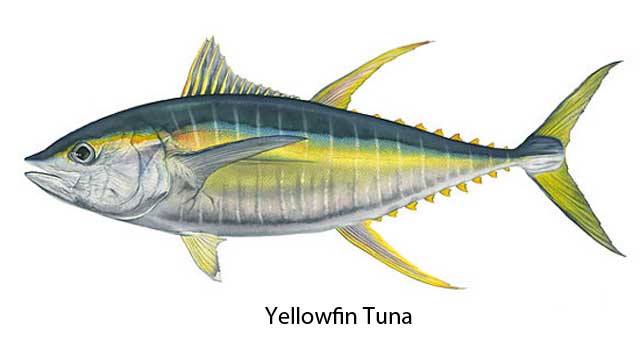
YELLOWFIN TUNA

Thunnus albacares
The yellowfin tuna is one of the largest of the tuna species.
The second dorsal fin and the anal fin, as well as the finlets between those fins and the tail, are bright yellow, giving this fish its common name. The second dorsal and anal fins can be very long in mature specimens, reaching almost as far back as the tail and giving the appearance of sickles or scimitars. The pectoral fins are also longer than the related bluefin tuna, but not as long as those of the albacore. The main body is very dark metallic blue, changing to silver on the belly, which has about 20 vertical lines.
Yellowfin tuna are epipalagic fish that inhabit the mixed surface layer of the ocean above the thermocline. Sonic tracking has found that although yellowfin tuna, unlike the related bigeye tuna, mostly range in the top 100 meters (330 ft) of the water column and penetrate the thermocline relatively infrequently, they are capable of diving to considerable depths.
Yellowfin tuna prey include other fish, pelagic crustaceans and squid. Like all tunas their body shape is evolved for speed, enabling them to pursue and capture fast-moving baitfish such as flying fish and mackerel; Schooling species such as anchovies and sardines are frequently taken. Large yellowfin prey on smaller members of the tuna family such as frigate mackerel and skipjack.
In turn, yellowfin are preyed upon when young by other pelagic hunters, including larger tuna, seabirds and predatory fishes such as wahoo, shark and billfish. As they increase in size and speed, yellowfin become able to escape most of their predators.
The record for this species stands at 388 pounds (176 kg), caught San Benedicto Island in the Pacific waters of Mexico. Carribean specimens are typically much smaller.